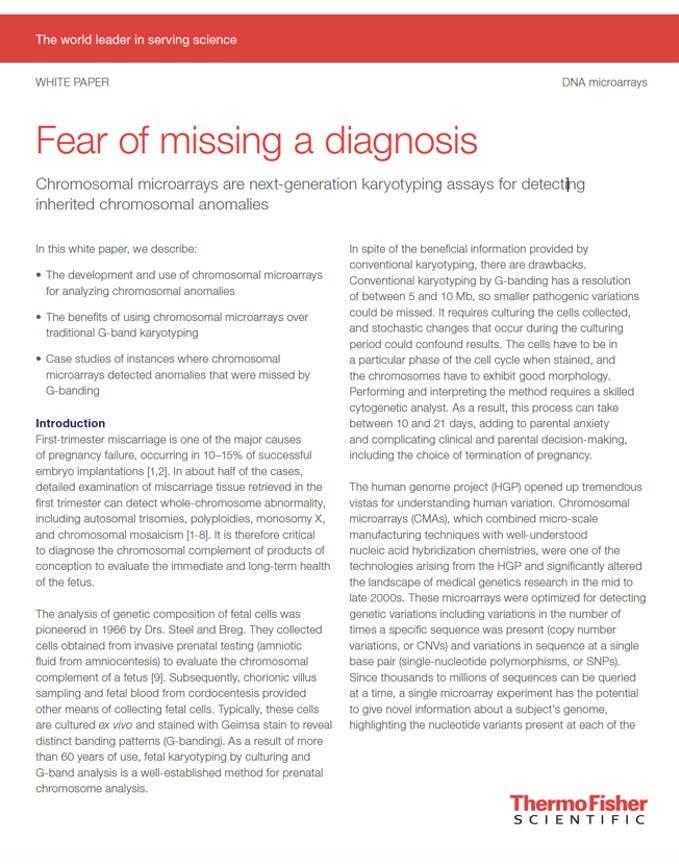Karyotyping has been a standard diagnostic method for prenatal testing for decades. As a method dating back to the late 1960s, it has had ample time to become a familiar, well-established method whose strengths and best practices are ingrained into the minds of prenatal testing technicians. As medical techniques become more sophisticated, however, the weaknesses of traditional karyotyping are becoming more obvious and more limiting, and newer methods such as chromosomal microarrays (CMAs) are slowly taking its place.
Limits of karyotyping
Conventional karyotyping makes use of G-banding, which applies Giemsa stain to isolated chromosomes to highlight areas of high adenine-thymine bonding. This creates distinct banding patterns (G-banding) that can reveal whether whole chromosomes or pieces of a chromosome are missing, transposed or otherwise aberrant, and from there, help diagnose numerous diseases that those chromosomal abnormalities cause.
Unfortunately, G-banding has limited resolution, at the level of 5-10 megabases, which means that it cannot detect abnormalities smaller than this limit. G-banding results are readable only in a specific cell-cycle phase and depend on intact chromosomes with good morphology, so many stained cells are unusable. Partly to mitigate the previous weakness, G-banding involves culturing the collected cells to generate enough material to analyze, which takes time and introduces small changes that can affect results. Reading a G-banded karyotype requires a skilled cytogenetic analyst, which adds more time and difficulty to the endeavor. When the results of a karyotype affect the fate of a pregnancy, the combined weeks of waiting can be anxious or even unacceptable.

Strengths of microarrays
Chromosomal microarrays avoid most of these pitfalls. Emerging out of the Human Genome Project in the mid to late 2000s, microarrays can test thousands or millions of distinct variations with a single assay. Cells studied with CMAs do not need to be alive or in a particular phase of the cell cycle, and do not need to be present in large numbers, so CMAs can collect data from raw samples with no need for culturing. CMAs can even be used on formalin-fixed, paraffin-embedded (FFPE) samples for comparative studies, such as between successful and failed in-vitro fertilization attempts.
By using small, well-defined probes rather than banding patterns and microscopes, microarrays can detect differences as small as 500 kilobases, several orders of magnitude smaller than the limit for traditional karyotyping, revealing microdeletions and microduplications that can cause illness and that are not visible with G-banding. Arrays with probes for single nucleotide polymorphisms (SNPs), called SNP arrays, can detect even smaller variations. The combination of these benefits with CMAs’ ease of use has led numerous organizations, such as the American College of Medical Genetics and American College of Obstetricians and Gynecologists, to recommend SNP arrays as a first-round test of choice, with other tests recommended as follow-ups.
Where karyotyping excels
Although it can appear that CMAs totally supplant conventional karyotyping, this is not the case. Although CMAs offer similar or improved performance relative to karyotyping for numerous kinds of abnormalities, they cannot easily detect balanced chromosomal rearrangements, such as translocations with no change in copy number. These kinds of changes are obvious in karyotypes and via fluorescence in-situ hybridization (FISH) and other visual detection methods, but largely invisible to arrays, including SNP arrays. As a result, karyotyping still has a place in the diagnostic toolkit alongside chromosomal microarrays and other techniques, and each tool can provide the insight needed to help new parents make informed decisions. When microarrays do not yield usable information, other methods like karyotyping make ideal next steps, filling in those gaps with their unique strengths.
For more information on prenatal and postnatal genetic testing, visit our education page here.
Leave a Reply